Economic Analysis of Cigarette Smoking and Unemployment in Australia
VerifiedAdded on 2023/06/03
|8
|2236
|274
Essay
AI Summary
This economics assignment provides a comprehensive analysis of cigarette smoking and unemployment in Australia. It begins by comparing smoking rates between Australia and New Zealand, followed by an examination of the effects of excise taxes on cigarettes, including elasticity of demand and graphical representations. The assignment then delves into a cost-benefit analysis of cigarette smoking, highlighting negative externalities and policies adopted to reduce smoking, such as bans in public places and plain packaging. The second part of the assignment explores different types of unemployment (structural, cyclical, frictional, hidden, and underemployment) and their causes. It also investigates factors affecting the supply and demand of 15-24-year-old workers, including education, migration, and the growth of the service sector. Finally, the assignment compares youth unemployment rates between Australia and New Zealand, and the factors driving part-time or casual employment among young workers, such as combining studies and work and changing economic structures.
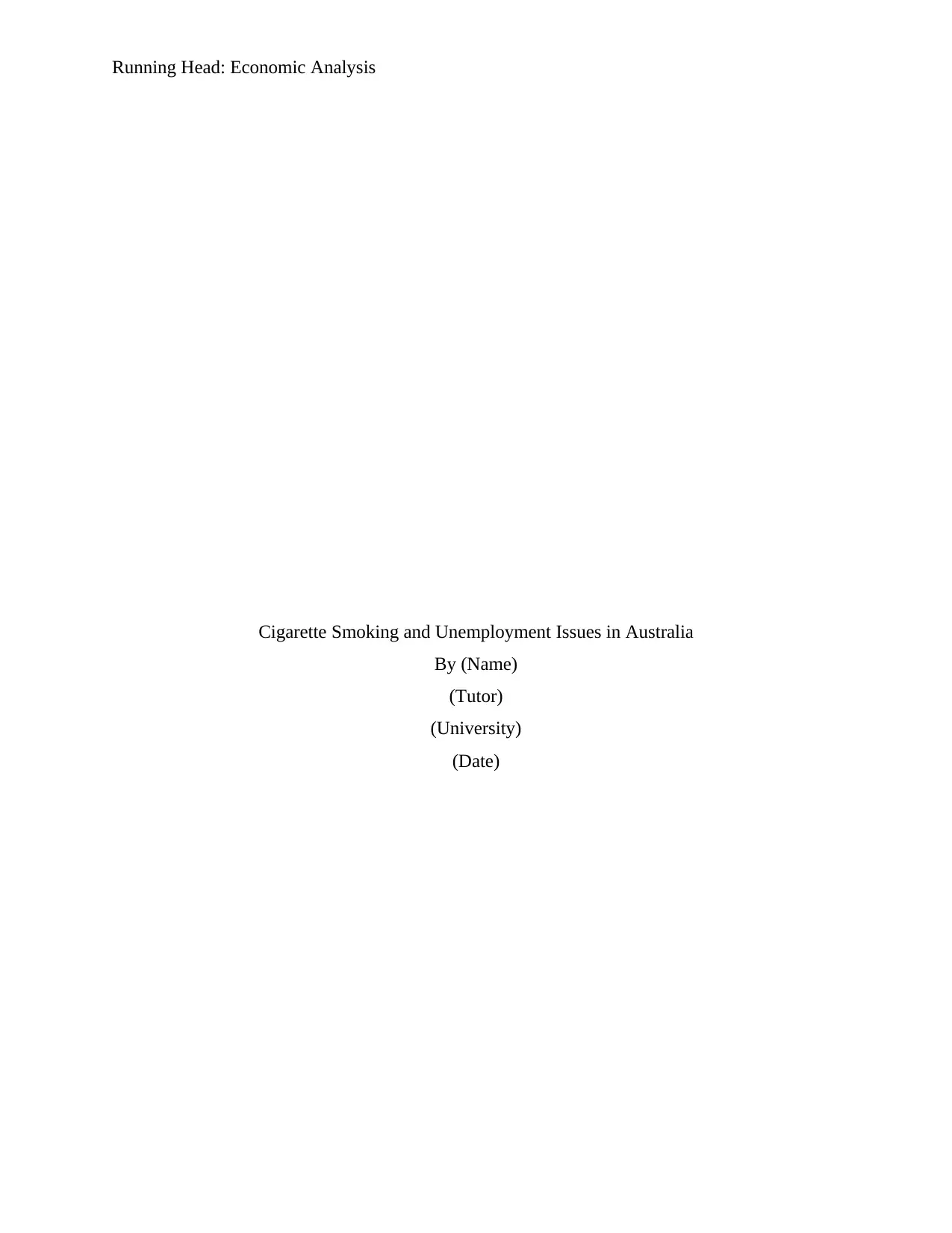
Running Head: Economic Analysis
Cigarette Smoking and Unemployment Issues in Australia
By (Name)
(Tutor)
(University)
(Date)
Cigarette Smoking and Unemployment Issues in Australia
By (Name)
(Tutor)
(University)
(Date)
Paraphrase This Document
Need a fresh take? Get an instant paraphrase of this document with our AI Paraphraser
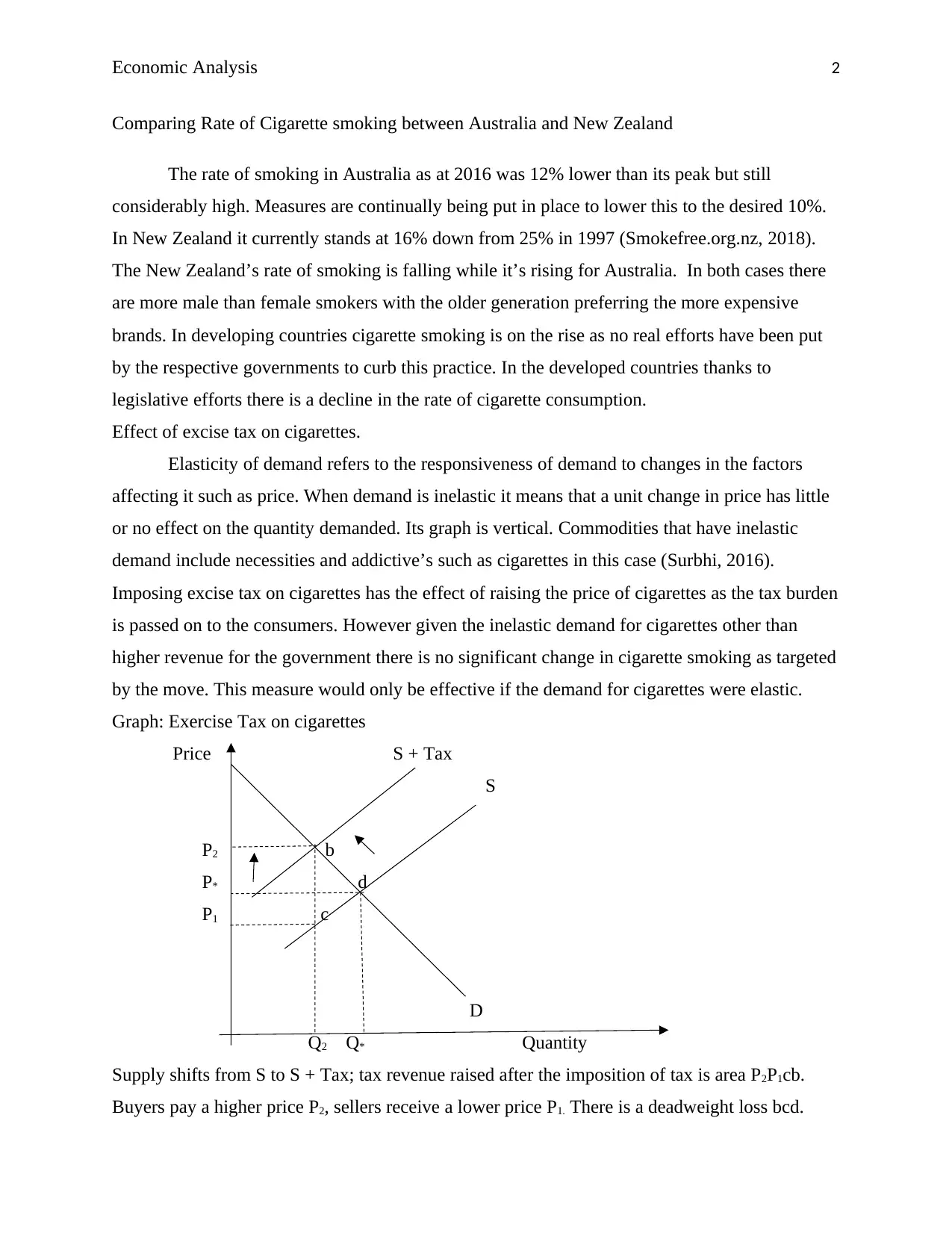
Economic Analysis 2
Comparing Rate of Cigarette smoking between Australia and New Zealand
The rate of smoking in Australia as at 2016 was 12% lower than its peak but still
considerably high. Measures are continually being put in place to lower this to the desired 10%.
In New Zealand it currently stands at 16% down from 25% in 1997 (Smokefree.org.nz, 2018).
The New Zealand’s rate of smoking is falling while it’s rising for Australia. In both cases there
are more male than female smokers with the older generation preferring the more expensive
brands. In developing countries cigarette smoking is on the rise as no real efforts have been put
by the respective governments to curb this practice. In the developed countries thanks to
legislative efforts there is a decline in the rate of cigarette consumption.
Effect of excise tax on cigarettes.
Elasticity of demand refers to the responsiveness of demand to changes in the factors
affecting it such as price. When demand is inelastic it means that a unit change in price has little
or no effect on the quantity demanded. Its graph is vertical. Commodities that have inelastic
demand include necessities and addictive’s such as cigarettes in this case (Surbhi, 2016).
Imposing excise tax on cigarettes has the effect of raising the price of cigarettes as the tax burden
is passed on to the consumers. However given the inelastic demand for cigarettes other than
higher revenue for the government there is no significant change in cigarette smoking as targeted
by the move. This measure would only be effective if the demand for cigarettes were elastic.
Graph: Exercise Tax on cigarettes
Price S + Tax
S
P2 b
P* d
P1 c
D
Q2 Q* Quantity
Supply shifts from S to S + Tax; tax revenue raised after the imposition of tax is area P2P1cb.
Buyers pay a higher price P2, sellers receive a lower price P1. There is a deadweight loss bcd.
Comparing Rate of Cigarette smoking between Australia and New Zealand
The rate of smoking in Australia as at 2016 was 12% lower than its peak but still
considerably high. Measures are continually being put in place to lower this to the desired 10%.
In New Zealand it currently stands at 16% down from 25% in 1997 (Smokefree.org.nz, 2018).
The New Zealand’s rate of smoking is falling while it’s rising for Australia. In both cases there
are more male than female smokers with the older generation preferring the more expensive
brands. In developing countries cigarette smoking is on the rise as no real efforts have been put
by the respective governments to curb this practice. In the developed countries thanks to
legislative efforts there is a decline in the rate of cigarette consumption.
Effect of excise tax on cigarettes.
Elasticity of demand refers to the responsiveness of demand to changes in the factors
affecting it such as price. When demand is inelastic it means that a unit change in price has little
or no effect on the quantity demanded. Its graph is vertical. Commodities that have inelastic
demand include necessities and addictive’s such as cigarettes in this case (Surbhi, 2016).
Imposing excise tax on cigarettes has the effect of raising the price of cigarettes as the tax burden
is passed on to the consumers. However given the inelastic demand for cigarettes other than
higher revenue for the government there is no significant change in cigarette smoking as targeted
by the move. This measure would only be effective if the demand for cigarettes were elastic.
Graph: Exercise Tax on cigarettes
Price S + Tax
S
P2 b
P* d
P1 c
D
Q2 Q* Quantity
Supply shifts from S to S + Tax; tax revenue raised after the imposition of tax is area P2P1cb.
Buyers pay a higher price P2, sellers receive a lower price P1. There is a deadweight loss bcd.
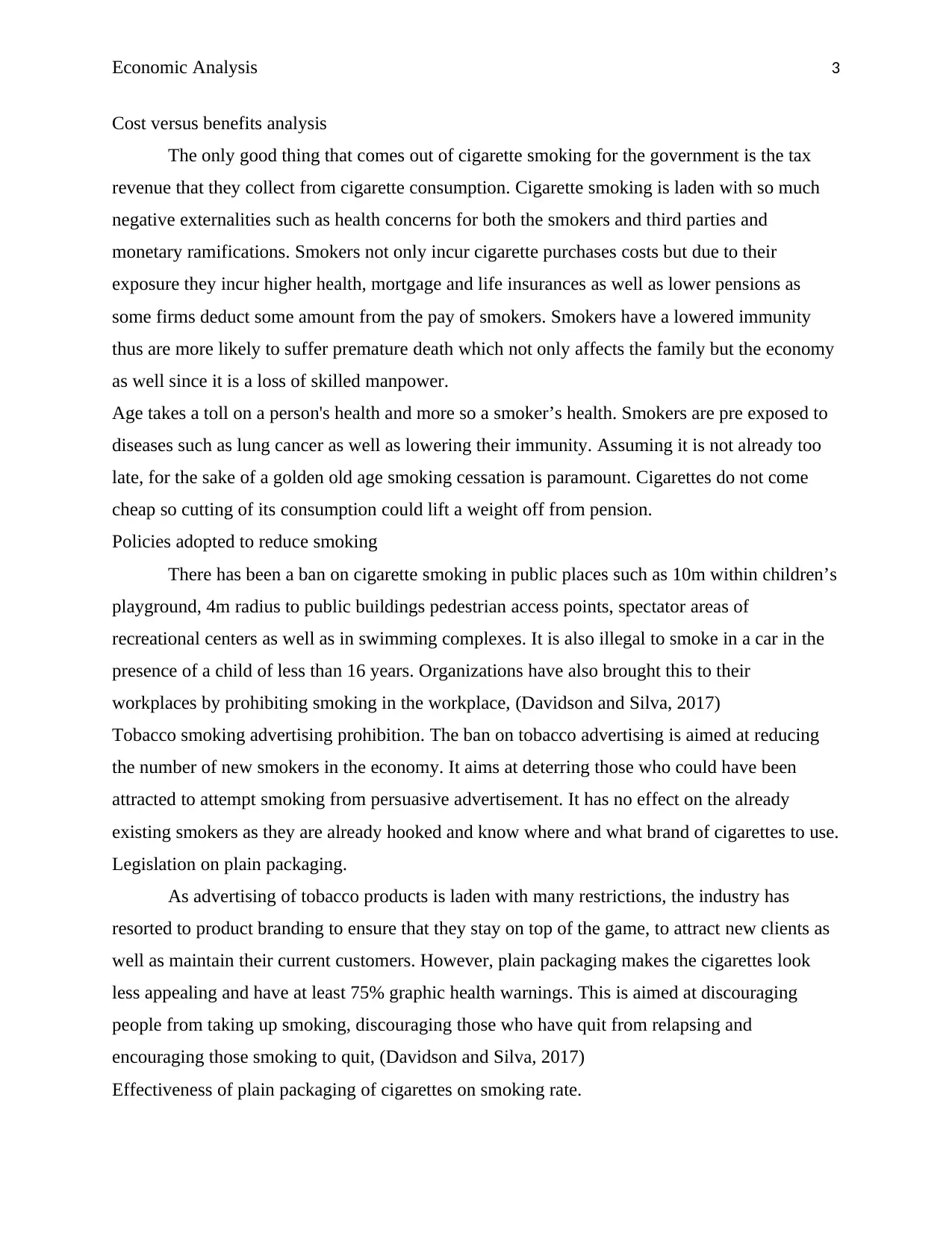
Economic Analysis 3
Cost versus benefits analysis
The only good thing that comes out of cigarette smoking for the government is the tax
revenue that they collect from cigarette consumption. Cigarette smoking is laden with so much
negative externalities such as health concerns for both the smokers and third parties and
monetary ramifications. Smokers not only incur cigarette purchases costs but due to their
exposure they incur higher health, mortgage and life insurances as well as lower pensions as
some firms deduct some amount from the pay of smokers. Smokers have a lowered immunity
thus are more likely to suffer premature death which not only affects the family but the economy
as well since it is a loss of skilled manpower.
Age takes a toll on a person's health and more so a smoker’s health. Smokers are pre exposed to
diseases such as lung cancer as well as lowering their immunity. Assuming it is not already too
late, for the sake of a golden old age smoking cessation is paramount. Cigarettes do not come
cheap so cutting of its consumption could lift a weight off from pension.
Policies adopted to reduce smoking
There has been a ban on cigarette smoking in public places such as 10m within children’s
playground, 4m radius to public buildings pedestrian access points, spectator areas of
recreational centers as well as in swimming complexes. It is also illegal to smoke in a car in the
presence of a child of less than 16 years. Organizations have also brought this to their
workplaces by prohibiting smoking in the workplace, (Davidson and Silva, 2017)
Tobacco smoking advertising prohibition. The ban on tobacco advertising is aimed at reducing
the number of new smokers in the economy. It aims at deterring those who could have been
attracted to attempt smoking from persuasive advertisement. It has no effect on the already
existing smokers as they are already hooked and know where and what brand of cigarettes to use.
Legislation on plain packaging.
As advertising of tobacco products is laden with many restrictions, the industry has
resorted to product branding to ensure that they stay on top of the game, to attract new clients as
well as maintain their current customers. However, plain packaging makes the cigarettes look
less appealing and have at least 75% graphic health warnings. This is aimed at discouraging
people from taking up smoking, discouraging those who have quit from relapsing and
encouraging those smoking to quit, (Davidson and Silva, 2017)
Effectiveness of plain packaging of cigarettes on smoking rate.
Cost versus benefits analysis
The only good thing that comes out of cigarette smoking for the government is the tax
revenue that they collect from cigarette consumption. Cigarette smoking is laden with so much
negative externalities such as health concerns for both the smokers and third parties and
monetary ramifications. Smokers not only incur cigarette purchases costs but due to their
exposure they incur higher health, mortgage and life insurances as well as lower pensions as
some firms deduct some amount from the pay of smokers. Smokers have a lowered immunity
thus are more likely to suffer premature death which not only affects the family but the economy
as well since it is a loss of skilled manpower.
Age takes a toll on a person's health and more so a smoker’s health. Smokers are pre exposed to
diseases such as lung cancer as well as lowering their immunity. Assuming it is not already too
late, for the sake of a golden old age smoking cessation is paramount. Cigarettes do not come
cheap so cutting of its consumption could lift a weight off from pension.
Policies adopted to reduce smoking
There has been a ban on cigarette smoking in public places such as 10m within children’s
playground, 4m radius to public buildings pedestrian access points, spectator areas of
recreational centers as well as in swimming complexes. It is also illegal to smoke in a car in the
presence of a child of less than 16 years. Organizations have also brought this to their
workplaces by prohibiting smoking in the workplace, (Davidson and Silva, 2017)
Tobacco smoking advertising prohibition. The ban on tobacco advertising is aimed at reducing
the number of new smokers in the economy. It aims at deterring those who could have been
attracted to attempt smoking from persuasive advertisement. It has no effect on the already
existing smokers as they are already hooked and know where and what brand of cigarettes to use.
Legislation on plain packaging.
As advertising of tobacco products is laden with many restrictions, the industry has
resorted to product branding to ensure that they stay on top of the game, to attract new clients as
well as maintain their current customers. However, plain packaging makes the cigarettes look
less appealing and have at least 75% graphic health warnings. This is aimed at discouraging
people from taking up smoking, discouraging those who have quit from relapsing and
encouraging those smoking to quit, (Davidson and Silva, 2017)
Effectiveness of plain packaging of cigarettes on smoking rate.
⊘ This is a preview!⊘
Do you want full access?
Subscribe today to unlock all pages.

Trusted by 1+ million students worldwide
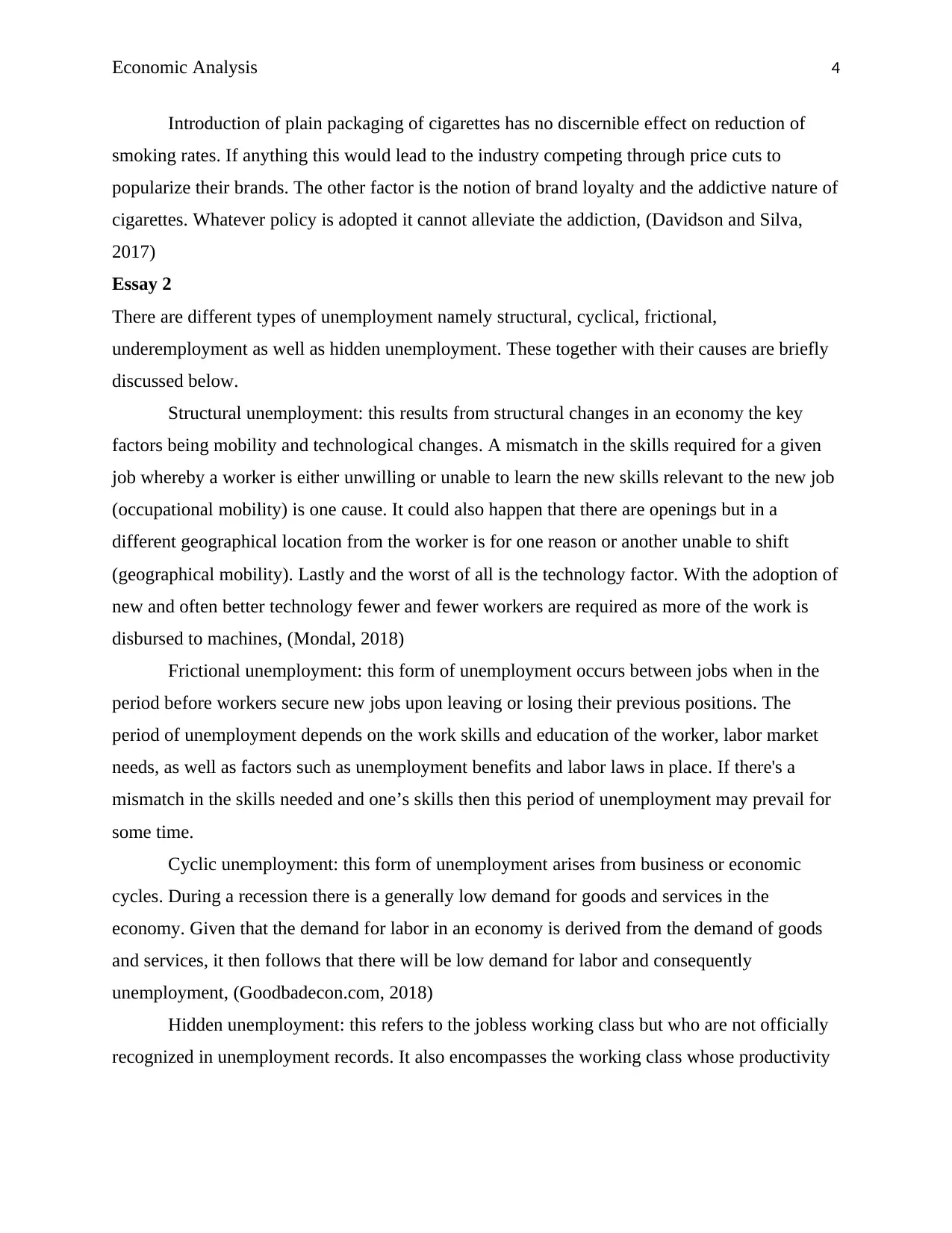
Economic Analysis 4
Introduction of plain packaging of cigarettes has no discernible effect on reduction of
smoking rates. If anything this would lead to the industry competing through price cuts to
popularize their brands. The other factor is the notion of brand loyalty and the addictive nature of
cigarettes. Whatever policy is adopted it cannot alleviate the addiction, (Davidson and Silva,
2017)
Essay 2
There are different types of unemployment namely structural, cyclical, frictional,
underemployment as well as hidden unemployment. These together with their causes are briefly
discussed below.
Structural unemployment: this results from structural changes in an economy the key
factors being mobility and technological changes. A mismatch in the skills required for a given
job whereby a worker is either unwilling or unable to learn the new skills relevant to the new job
(occupational mobility) is one cause. It could also happen that there are openings but in a
different geographical location from the worker is for one reason or another unable to shift
(geographical mobility). Lastly and the worst of all is the technology factor. With the adoption of
new and often better technology fewer and fewer workers are required as more of the work is
disbursed to machines, (Mondal, 2018)
Frictional unemployment: this form of unemployment occurs between jobs when in the
period before workers secure new jobs upon leaving or losing their previous positions. The
period of unemployment depends on the work skills and education of the worker, labor market
needs, as well as factors such as unemployment benefits and labor laws in place. If there's a
mismatch in the skills needed and one’s skills then this period of unemployment may prevail for
some time.
Cyclic unemployment: this form of unemployment arises from business or economic
cycles. During a recession there is a generally low demand for goods and services in the
economy. Given that the demand for labor in an economy is derived from the demand of goods
and services, it then follows that there will be low demand for labor and consequently
unemployment, (Goodbadecon.com, 2018)
Hidden unemployment: this refers to the jobless working class but who are not officially
recognized in unemployment records. It also encompasses the working class whose productivity
Introduction of plain packaging of cigarettes has no discernible effect on reduction of
smoking rates. If anything this would lead to the industry competing through price cuts to
popularize their brands. The other factor is the notion of brand loyalty and the addictive nature of
cigarettes. Whatever policy is adopted it cannot alleviate the addiction, (Davidson and Silva,
2017)
Essay 2
There are different types of unemployment namely structural, cyclical, frictional,
underemployment as well as hidden unemployment. These together with their causes are briefly
discussed below.
Structural unemployment: this results from structural changes in an economy the key
factors being mobility and technological changes. A mismatch in the skills required for a given
job whereby a worker is either unwilling or unable to learn the new skills relevant to the new job
(occupational mobility) is one cause. It could also happen that there are openings but in a
different geographical location from the worker is for one reason or another unable to shift
(geographical mobility). Lastly and the worst of all is the technology factor. With the adoption of
new and often better technology fewer and fewer workers are required as more of the work is
disbursed to machines, (Mondal, 2018)
Frictional unemployment: this form of unemployment occurs between jobs when in the
period before workers secure new jobs upon leaving or losing their previous positions. The
period of unemployment depends on the work skills and education of the worker, labor market
needs, as well as factors such as unemployment benefits and labor laws in place. If there's a
mismatch in the skills needed and one’s skills then this period of unemployment may prevail for
some time.
Cyclic unemployment: this form of unemployment arises from business or economic
cycles. During a recession there is a generally low demand for goods and services in the
economy. Given that the demand for labor in an economy is derived from the demand of goods
and services, it then follows that there will be low demand for labor and consequently
unemployment, (Goodbadecon.com, 2018)
Hidden unemployment: this refers to the jobless working class but who are not officially
recognized in unemployment records. It also encompasses the working class whose productivity
Paraphrase This Document
Need a fresh take? Get an instant paraphrase of this document with our AI Paraphraser
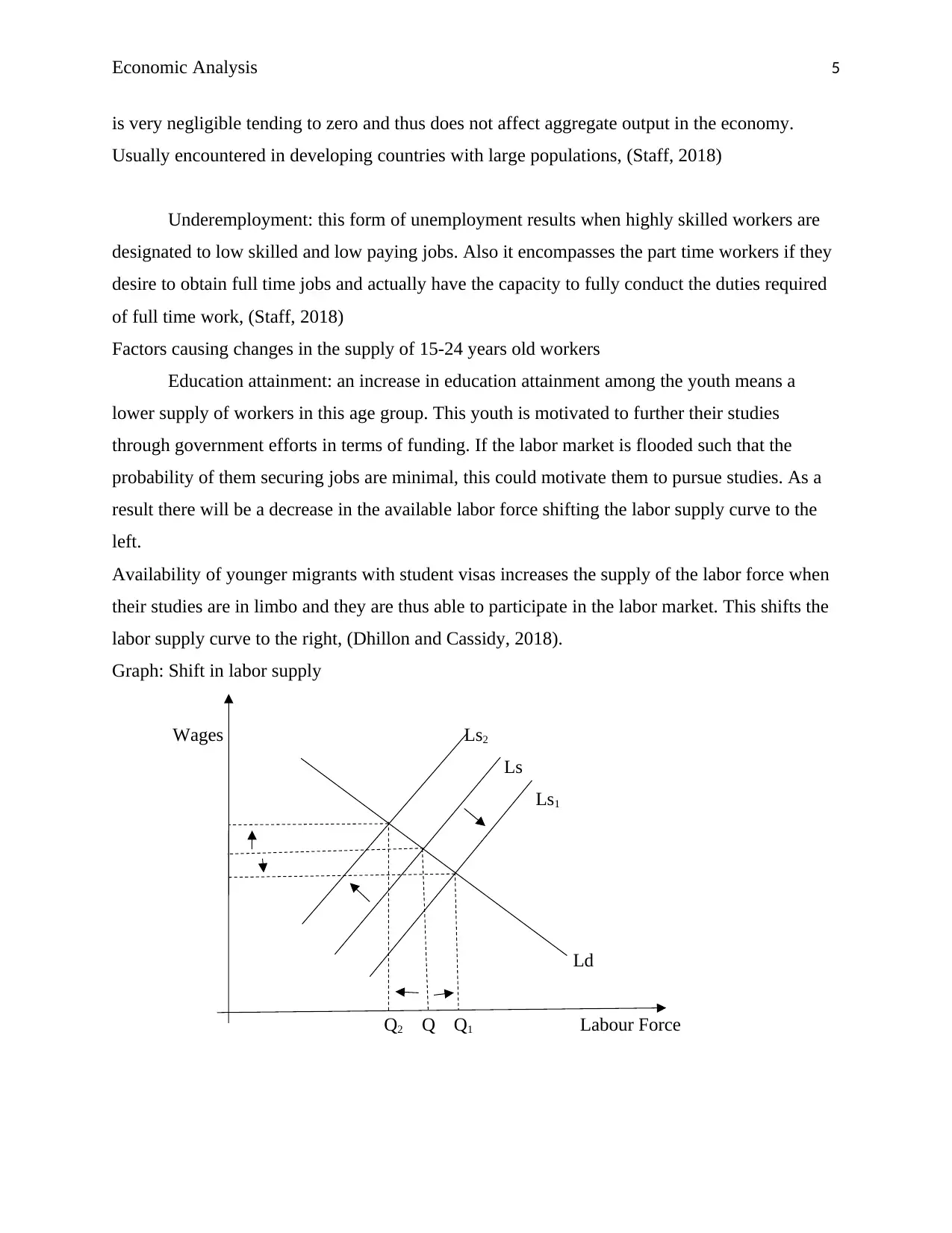
Economic Analysis 5
is very negligible tending to zero and thus does not affect aggregate output in the economy.
Usually encountered in developing countries with large populations, (Staff, 2018)
Underemployment: this form of unemployment results when highly skilled workers are
designated to low skilled and low paying jobs. Also it encompasses the part time workers if they
desire to obtain full time jobs and actually have the capacity to fully conduct the duties required
of full time work, (Staff, 2018)
Factors causing changes in the supply of 15-24 years old workers
Education attainment: an increase in education attainment among the youth means a
lower supply of workers in this age group. This youth is motivated to further their studies
through government efforts in terms of funding. If the labor market is flooded such that the
probability of them securing jobs are minimal, this could motivate them to pursue studies. As a
result there will be a decrease in the available labor force shifting the labor supply curve to the
left.
Availability of younger migrants with student visas increases the supply of the labor force when
their studies are in limbo and they are thus able to participate in the labor market. This shifts the
labor supply curve to the right, (Dhillon and Cassidy, 2018).
Graph: Shift in labor supply
Wages Ls2
Ls
Ls1
Ld
Q2 Q Q1 Labour Force
is very negligible tending to zero and thus does not affect aggregate output in the economy.
Usually encountered in developing countries with large populations, (Staff, 2018)
Underemployment: this form of unemployment results when highly skilled workers are
designated to low skilled and low paying jobs. Also it encompasses the part time workers if they
desire to obtain full time jobs and actually have the capacity to fully conduct the duties required
of full time work, (Staff, 2018)
Factors causing changes in the supply of 15-24 years old workers
Education attainment: an increase in education attainment among the youth means a
lower supply of workers in this age group. This youth is motivated to further their studies
through government efforts in terms of funding. If the labor market is flooded such that the
probability of them securing jobs are minimal, this could motivate them to pursue studies. As a
result there will be a decrease in the available labor force shifting the labor supply curve to the
left.
Availability of younger migrants with student visas increases the supply of the labor force when
their studies are in limbo and they are thus able to participate in the labor market. This shifts the
labor supply curve to the right, (Dhillon and Cassidy, 2018).
Graph: Shift in labor supply
Wages Ls2
Ls
Ls1
Ld
Q2 Q Q1 Labour Force
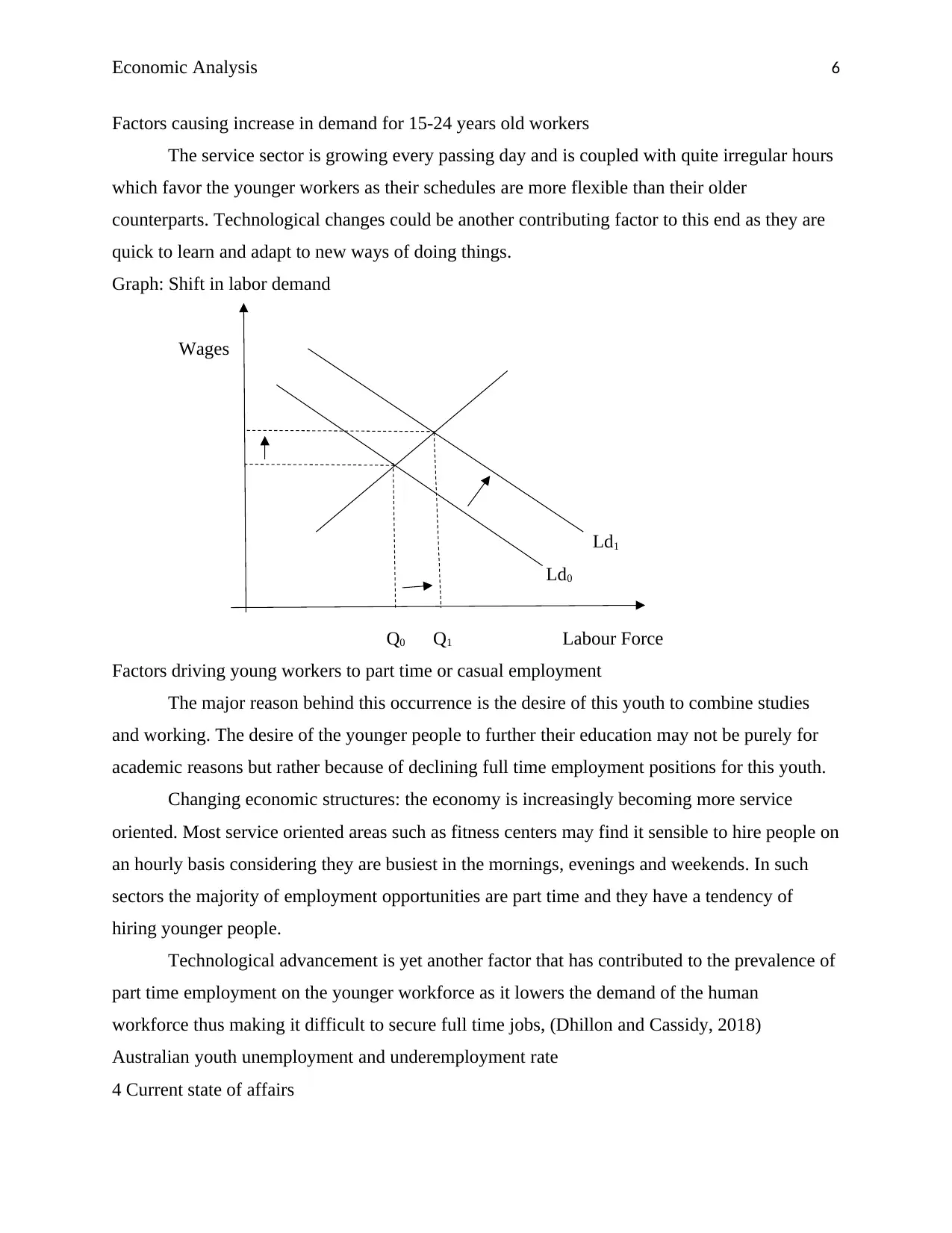
Economic Analysis 6
Factors causing increase in demand for 15-24 years old workers
The service sector is growing every passing day and is coupled with quite irregular hours
which favor the younger workers as their schedules are more flexible than their older
counterparts. Technological changes could be another contributing factor to this end as they are
quick to learn and adapt to new ways of doing things.
Graph: Shift in labor demand
Wages
Ld1
Ld0
Q0 Q1 Labour Force
Factors driving young workers to part time or casual employment
The major reason behind this occurrence is the desire of this youth to combine studies
and working. The desire of the younger people to further their education may not be purely for
academic reasons but rather because of declining full time employment positions for this youth.
Changing economic structures: the economy is increasingly becoming more service
oriented. Most service oriented areas such as fitness centers may find it sensible to hire people on
an hourly basis considering they are busiest in the mornings, evenings and weekends. In such
sectors the majority of employment opportunities are part time and they have a tendency of
hiring younger people.
Technological advancement is yet another factor that has contributed to the prevalence of
part time employment on the younger workforce as it lowers the demand of the human
workforce thus making it difficult to secure full time jobs, (Dhillon and Cassidy, 2018)
Australian youth unemployment and underemployment rate
4 Current state of affairs
Factors causing increase in demand for 15-24 years old workers
The service sector is growing every passing day and is coupled with quite irregular hours
which favor the younger workers as their schedules are more flexible than their older
counterparts. Technological changes could be another contributing factor to this end as they are
quick to learn and adapt to new ways of doing things.
Graph: Shift in labor demand
Wages
Ld1
Ld0
Q0 Q1 Labour Force
Factors driving young workers to part time or casual employment
The major reason behind this occurrence is the desire of this youth to combine studies
and working. The desire of the younger people to further their education may not be purely for
academic reasons but rather because of declining full time employment positions for this youth.
Changing economic structures: the economy is increasingly becoming more service
oriented. Most service oriented areas such as fitness centers may find it sensible to hire people on
an hourly basis considering they are busiest in the mornings, evenings and weekends. In such
sectors the majority of employment opportunities are part time and they have a tendency of
hiring younger people.
Technological advancement is yet another factor that has contributed to the prevalence of
part time employment on the younger workforce as it lowers the demand of the human
workforce thus making it difficult to secure full time jobs, (Dhillon and Cassidy, 2018)
Australian youth unemployment and underemployment rate
4 Current state of affairs
⊘ This is a preview!⊘
Do you want full access?
Subscribe today to unlock all pages.

Trusted by 1+ million students worldwide
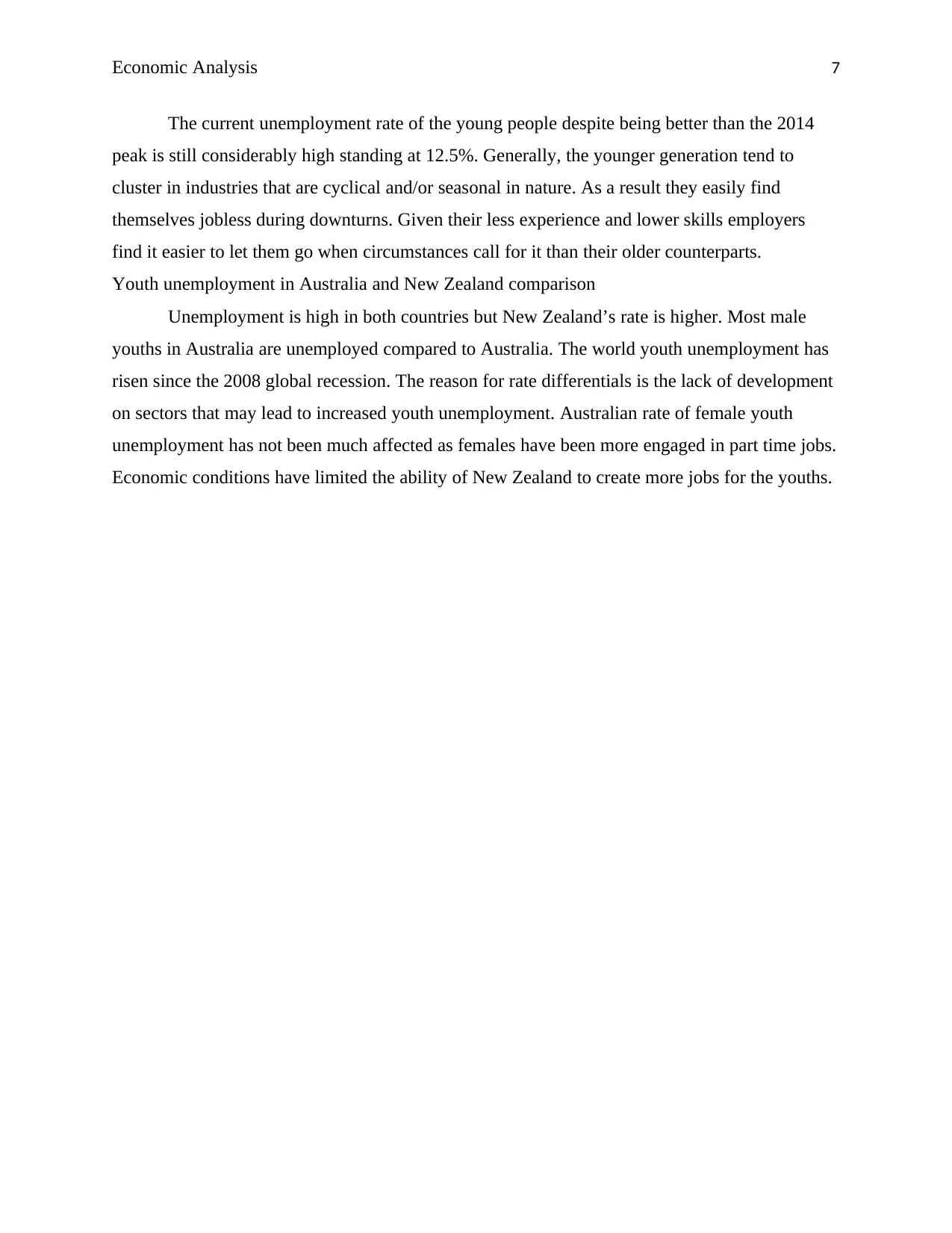
Economic Analysis 7
The current unemployment rate of the young people despite being better than the 2014
peak is still considerably high standing at 12.5%. Generally, the younger generation tend to
cluster in industries that are cyclical and/or seasonal in nature. As a result they easily find
themselves jobless during downturns. Given their less experience and lower skills employers
find it easier to let them go when circumstances call for it than their older counterparts.
Youth unemployment in Australia and New Zealand comparison
Unemployment is high in both countries but New Zealand’s rate is higher. Most male
youths in Australia are unemployed compared to Australia. The world youth unemployment has
risen since the 2008 global recession. The reason for rate differentials is the lack of development
on sectors that may lead to increased youth unemployment. Australian rate of female youth
unemployment has not been much affected as females have been more engaged in part time jobs.
Economic conditions have limited the ability of New Zealand to create more jobs for the youths.
The current unemployment rate of the young people despite being better than the 2014
peak is still considerably high standing at 12.5%. Generally, the younger generation tend to
cluster in industries that are cyclical and/or seasonal in nature. As a result they easily find
themselves jobless during downturns. Given their less experience and lower skills employers
find it easier to let them go when circumstances call for it than their older counterparts.
Youth unemployment in Australia and New Zealand comparison
Unemployment is high in both countries but New Zealand’s rate is higher. Most male
youths in Australia are unemployed compared to Australia. The world youth unemployment has
risen since the 2008 global recession. The reason for rate differentials is the lack of development
on sectors that may lead to increased youth unemployment. Australian rate of female youth
unemployment has not been much affected as females have been more engaged in part time jobs.
Economic conditions have limited the ability of New Zealand to create more jobs for the youths.
Paraphrase This Document
Need a fresh take? Get an instant paraphrase of this document with our AI Paraphraser
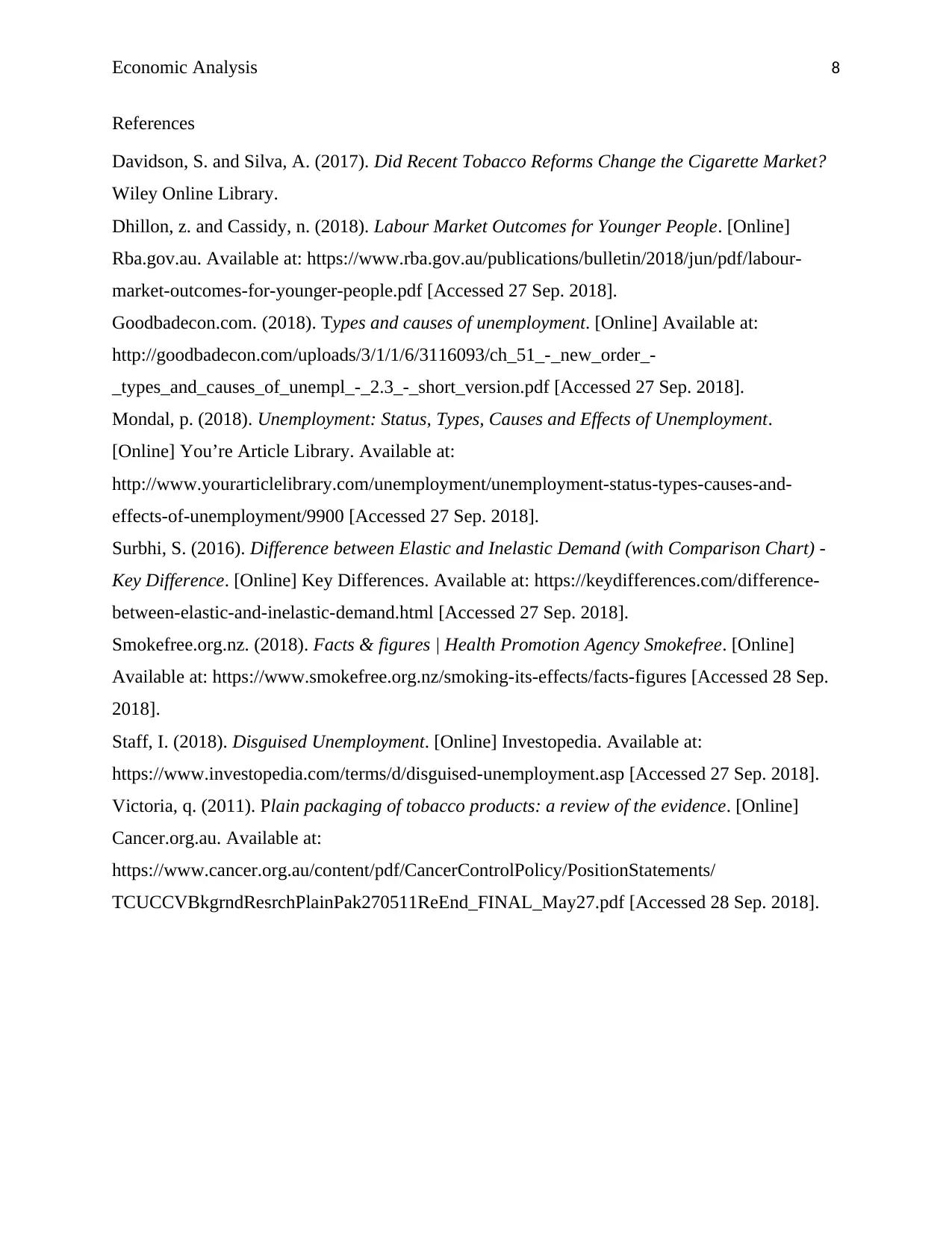
Economic Analysis 8
References
Davidson, S. and Silva, A. (2017). Did Recent Tobacco Reforms Change the Cigarette Market?
Wiley Online Library.
Dhillon, z. and Cassidy, n. (2018). Labour Market Outcomes for Younger People. [Online]
Rba.gov.au. Available at: https://www.rba.gov.au/publications/bulletin/2018/jun/pdf/labour-
market-outcomes-for-younger-people.pdf [Accessed 27 Sep. 2018].
Goodbadecon.com. (2018). Types and causes of unemployment. [Online] Available at:
http://goodbadecon.com/uploads/3/1/1/6/3116093/ch_51_-_new_order_-
_types_and_causes_of_unempl_-_2.3_-_short_version.pdf [Accessed 27 Sep. 2018].
Mondal, p. (2018). Unemployment: Status, Types, Causes and Effects of Unemployment.
[Online] You’re Article Library. Available at:
http://www.yourarticlelibrary.com/unemployment/unemployment-status-types-causes-and-
effects-of-unemployment/9900 [Accessed 27 Sep. 2018].
Surbhi, S. (2016). Difference between Elastic and Inelastic Demand (with Comparison Chart) -
Key Difference. [Online] Key Differences. Available at: https://keydifferences.com/difference-
between-elastic-and-inelastic-demand.html [Accessed 27 Sep. 2018].
Smokefree.org.nz. (2018). Facts & figures | Health Promotion Agency Smokefree. [Online]
Available at: https://www.smokefree.org.nz/smoking-its-effects/facts-figures [Accessed 28 Sep.
2018].
Staff, I. (2018). Disguised Unemployment. [Online] Investopedia. Available at:
https://www.investopedia.com/terms/d/disguised-unemployment.asp [Accessed 27 Sep. 2018].
Victoria, q. (2011). Plain packaging of tobacco products: a review of the evidence. [Online]
Cancer.org.au. Available at:
https://www.cancer.org.au/content/pdf/CancerControlPolicy/PositionStatements/
TCUCCVBkgrndResrchPlainPak270511ReEnd_FINAL_May27.pdf [Accessed 28 Sep. 2018].
References
Davidson, S. and Silva, A. (2017). Did Recent Tobacco Reforms Change the Cigarette Market?
Wiley Online Library.
Dhillon, z. and Cassidy, n. (2018). Labour Market Outcomes for Younger People. [Online]
Rba.gov.au. Available at: https://www.rba.gov.au/publications/bulletin/2018/jun/pdf/labour-
market-outcomes-for-younger-people.pdf [Accessed 27 Sep. 2018].
Goodbadecon.com. (2018). Types and causes of unemployment. [Online] Available at:
http://goodbadecon.com/uploads/3/1/1/6/3116093/ch_51_-_new_order_-
_types_and_causes_of_unempl_-_2.3_-_short_version.pdf [Accessed 27 Sep. 2018].
Mondal, p. (2018). Unemployment: Status, Types, Causes and Effects of Unemployment.
[Online] You’re Article Library. Available at:
http://www.yourarticlelibrary.com/unemployment/unemployment-status-types-causes-and-
effects-of-unemployment/9900 [Accessed 27 Sep. 2018].
Surbhi, S. (2016). Difference between Elastic and Inelastic Demand (with Comparison Chart) -
Key Difference. [Online] Key Differences. Available at: https://keydifferences.com/difference-
between-elastic-and-inelastic-demand.html [Accessed 27 Sep. 2018].
Smokefree.org.nz. (2018). Facts & figures | Health Promotion Agency Smokefree. [Online]
Available at: https://www.smokefree.org.nz/smoking-its-effects/facts-figures [Accessed 28 Sep.
2018].
Staff, I. (2018). Disguised Unemployment. [Online] Investopedia. Available at:
https://www.investopedia.com/terms/d/disguised-unemployment.asp [Accessed 27 Sep. 2018].
Victoria, q. (2011). Plain packaging of tobacco products: a review of the evidence. [Online]
Cancer.org.au. Available at:
https://www.cancer.org.au/content/pdf/CancerControlPolicy/PositionStatements/
TCUCCVBkgrndResrchPlainPak270511ReEnd_FINAL_May27.pdf [Accessed 28 Sep. 2018].
1 out of 8
Related Documents
Your All-in-One AI-Powered Toolkit for Academic Success.
+13062052269
info@desklib.com
Available 24*7 on WhatsApp / Email
![[object Object]](/_next/static/media/star-bottom.7253800d.svg)
Unlock your academic potential
Copyright © 2020–2025 A2Z Services. All Rights Reserved. Developed and managed by ZUCOL.





